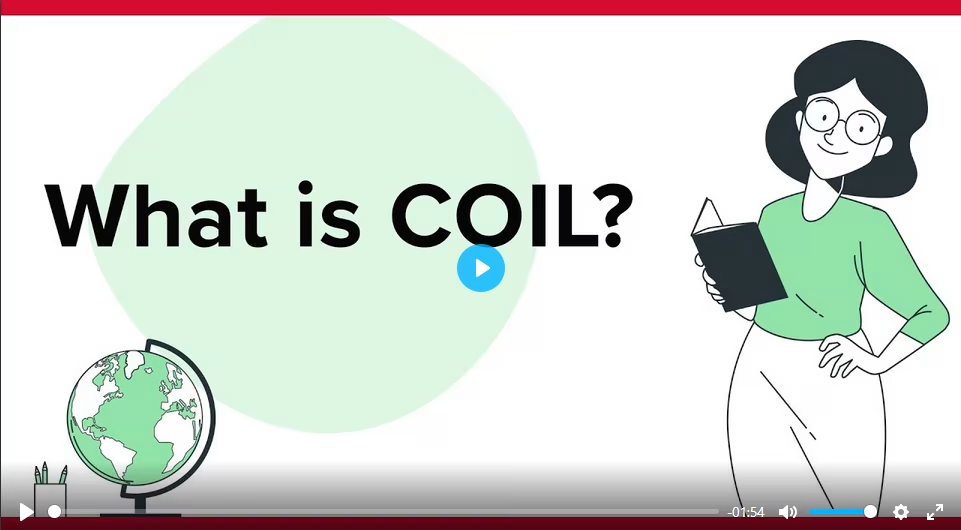COIL: Internationalize Your Teaching Through Virtual Collaboration

In a nutshell
Video: What is COIL?, YouTube, © BeCoil
COIL (Collaborative Online International Learning) is a low-barrier way to internationalize your teaching—without the logistics of travel. It connects your classroom with students and educators abroad to collaborate on shared, curriculum-integrated projects. Through these guided virtual exchanges, students
- build intercultural communication skills
- develop global awareness
- strengthen digital collaboration abilities
- deepen subject-specific knowledge through applied learning
For you as lecturers, COIL offers an exciting opportunity to
- enrich your course with international perspectives
- expand your professional network through global partnerships
- experiment with innovative pedagogical approaches and teaching formats
- increase student engagement through real-world, cross-cultural collaboration
- enhance your own intercultural competence by co-teaching with international colleagues
COIL is flexible, scalable, and highly rewarding—for you and your students.
How to start a COIL
Starting a COIL project means connecting your course with a partner at another university to give students a structured, international learning experience—online and integrated into your existing teaching. This four-step guide walks you through the full process: from finding a suitable course and international partner, to designing shared activities, facilitating collaboration between students, and finally reflecting on what worked and what can be improved. COIL does not require a complete course overhaul—just the willingness to open your classroom to new perspectives.
1. Starting the Journey: Setting Up a COIL Partnership
Before students ever meet, COIL begins with identifying the right course and finding a like-minded international partner. You can find partners through your personal network or with assistance from the university. Educators align their course content and objectives, find common ground, and plan the collaboration framework. Early discussions cover academic calendars, time zones, digital tools, and teaching styles. At this stage, it is all about laying a strong foundation: What do we want students to learn, and how can they benefit from working across cultures?
Tip
Before planning content, set up an informal virtual coffee chat with your COIL partner to share teaching styles, course goals, and cultural backgrounds. This builds trust and opens up honest dialogue from the start. For further information, see our article on setting up a COIL project.
2. Designing the Experience: Conceptualizing the COIL Course
Once the partnership is formed, it is time to design a meaningful and engaging COIL experience. This phase involves defining shared learning goals, structuring student activities, selecting digital tools, and creating a timeline that works across institutions. Educators ensure students collaborate—not just cooperate—by designing interactive tasks and clear expectations. When done well, this stage bridges theory and practice in a truly global classroom.
Tip
Plan activities that require interdependence—students should need each other to succeed.
3. Bringing It to Life: Implementing the COIL Project
Now the students take the stage. Through synchronous and asynchronous activities, teams work across borders on real-world challenges. They learn to navigate cultural differences, time zones, and digital platforms while developing critical global competencies. By the end, students not only achieve the course outcomes—they have also grown as global citizens.
Tip
Schedule informal check-ins (either synchronous or asynchronous) midway through the project to troubleshoot, share progress, and adjust tasks or timelines if needed.
4. Looking Back to Move Forward: Reflecting on the COIL Experience
The final phase of a COIL project is all about stepping back and making sense of the journey. Students reflect on what they have learned—about the subject matter, digital collaboration, and intercultural teamwork—while instructors assess what went well and what could be improved. This stage is not just about evaluation; it is about learning from experience. Educators analyze student feedback, refine their approach, and lay the groundwork for future COIL ventures. With each iteration, the collaboration grows stronger and more impactful.
Tip
Stay in touch – plan a follow-up meeting with your partner months later to brainstorm future iterations or new course ideas.
What your COIL could look like
Here are some examples of COILs for your inspiration:
Any questions?
Do not hesitate to reach out to us: coil-projects@th-koeln.de!
Links & Literatur
- Berlin Universities‘ Joint Project on Collaborative Online International Learning
- TH Köln: PIONEERing COIL
- Commander, N. E., Schloer, W. F., & Cushing, S. T. (2022). Virtual exchange: a promising high-impact practice for developing intercultural effectiveness across disciplines. Journal of Virtual Exchange, 5,1-19. https://doi.org/10.21827/jve.5.37329
Header-Bild: © ZLE


